A horse gently pulls an old mining cart deep into the forest. It comes to a stop at a hole in the ground with a wooden staircase leading down. The staircase wraps back and forth, climbing 40 feet down into a small crevice. At the bottom of this fissure, a small pool awaits with pitch-black water.
Want to climb in? If not, don’t be worried. You’ll have the chance to swim at two other underground watering holes – known as cenotes. They aren’t quite so intimidating but are equally as beautiful.
Sound like a fun adventure? Then you need to head to Cenotes Cuzama. This wonderful group of cenotes is just south of the great city of Merida, Yucatan in Mexico, and is an incredible experience.
We love finding incredible cenotes on the Yucatan peninsula, where they’re unbelievably common. Dos Ojos is our favorite near Playa del Carmen, but this set of three located not too far outside of the city of Merida are some of the best we’ve ever encountered.
The first cenote (Tzapakal) is the narrow, deep crevice described above. Next to it, a second one (Santa Cruz) has a wider entrance with a gentle slope leading down to a shallow pool. More family-friendly. At the last stop (Chelentun), a deep cenote opens up to a large cavern and you can swim in the water which rivals the size of an Olympic swimming pool!
Cenotes, if you aren’t familiar, are large sinkholes in the limestone bedrock covering the Yucatan Peninsula which is filled with fresh water. The Maya civilization believed they were the gateways to the underworld, holding significant purpose and meaning to the people of the time. Now, they are commonly used for swimming, cave exploration, and enjoying the beautiful scenery within.
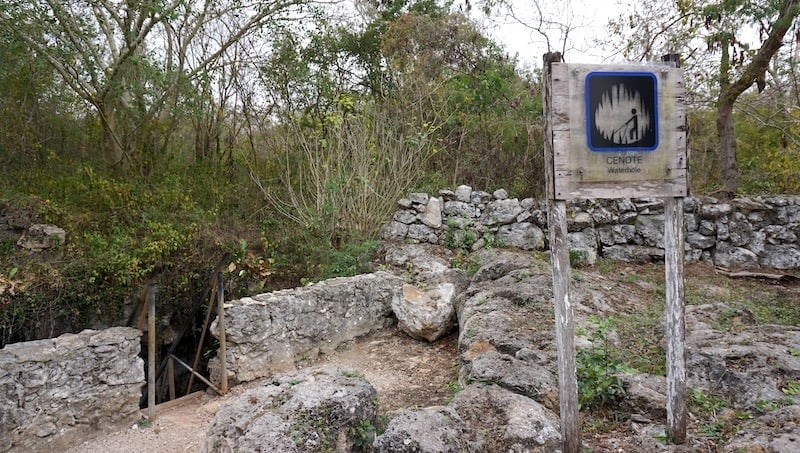
Clarification on Cenotes Cuzama
It can be quite confusing to reach the cenotes Cuzama. While the original group of three have been around for decades, other imposter groups have started sprouting up all over the town of Cuzama and the surrounding area. Don’t get fooled into visiting these!
Don’t stop in the towns of Cuzama or Homun to find the original three. The oldest – and what we have been told is the best group – is actually called Paradero Cenotes Chunkanán (click here for the exact Google listing and location). In order to get to these, you will pass by MANY other cenote sites. And they have people on the road, waving you in with large signs saying “CENOTES” and even touting the fact that they also use horse-drawn carts to take you to three cenotes. Complete copycats.
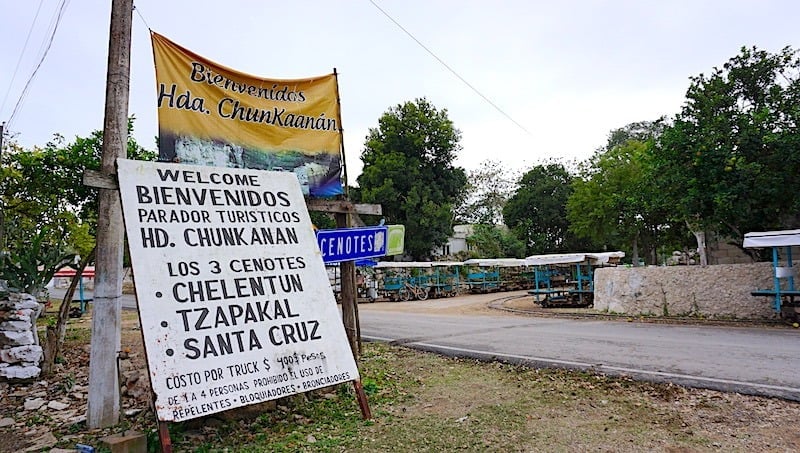
We’ll list off the many options at the end of this post, but just keep in mind that the original is actually Paradero Cenotes Chunkanán.
Hop-On the Horse-Drawn Cart at Cenotes Chunkanan
Once you arrive at the cenotes Cuzama (Paradero Cenotes Chunkanán), you’ll find a small parking lot on the left (east) side of the road. The horse-drawn carts on the opposite side of the road, already resting on the old mining rails. You park here and then speak to them about visiting the cenotes. The cost is usually $400 pesos per cart (up to four people) and includes all three cenotes.
On the day we visited, it was a bit rainy and we made sure to leave Merida early. It was perfect. Not many other tourists were there. We hopped on and started making our way away from town and into the forest.
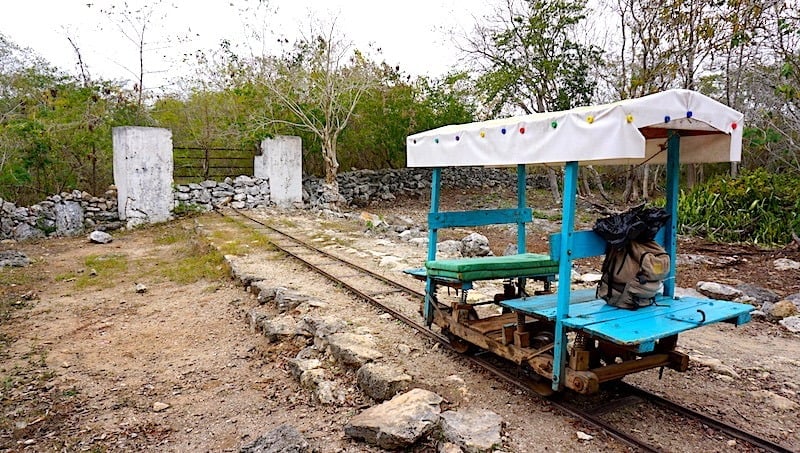
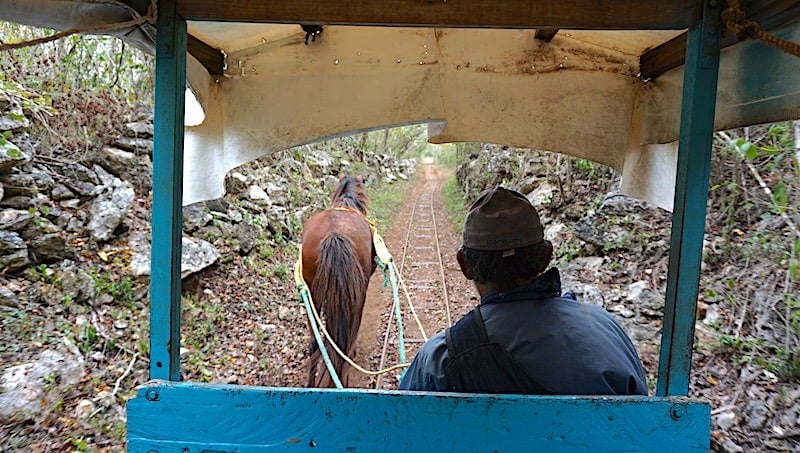
The vegetation is dense, basically a semi-arid jungle, with tons of small trees, bushes, and vines growing all around. You can spot iguanas all over, as well as quite a few birds and maybe a few other small animals if you have a keen eye.
As the wheels turn, they constantly clank against the slightly uneven track. The pathway is old and bumpy. Don’t worry – they seem to hold on better than you’d imagine. And the top speed is quite slow. It takes about 15 minutes to get to the first stop, where the first two cenotes are at.
A Small Fissure – The First Cenote Cuzama: Tzapakal
Our guide noticed that there were no belongings at the top of the smallest cenote, Tzapakal, so he waved us over to it. Then he yelled down the staircase to see if anyone was there.
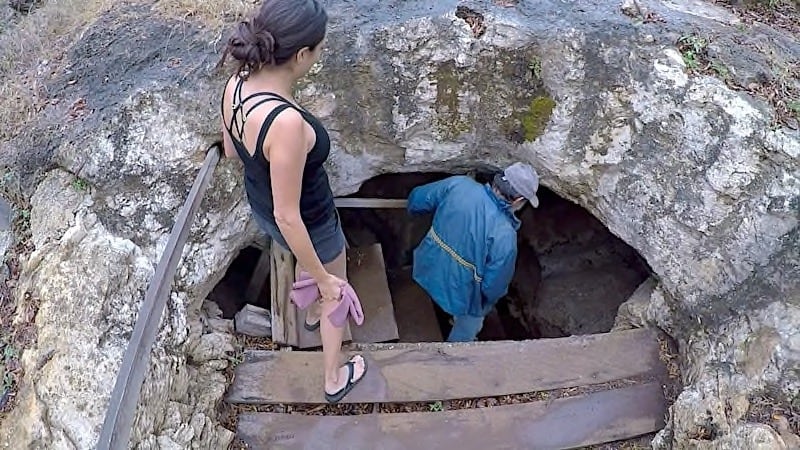
To his surprise, two voices yelled back in return. No, they weren’t the ghosts of Maya sacrifices from long ago. Just two fellow tourists swimming about.
It’s big enough for you as well, he said. So we started to climb down the old, wooden staircase. It twists back and forth, then spirals around, and ends with a ladder-like staircase for the final 15 feet. At the base, a patio around is about 10 feet wide and sits just above the water. And the only light comes from two small bulbs powered by a nearby generator.
When I looked up, I saw a sight I never imagined I would. Two flat surfaces shot high up into the air, back toward ground-level. And underneath them was water. Pitch-black water. The surface of the pool is about 8 ft wide by 20 ft long (2.4 m x 6 m). And the guide says it’s over 80 ft (25 m) deep. Unbelievable. And also a bit frightening.
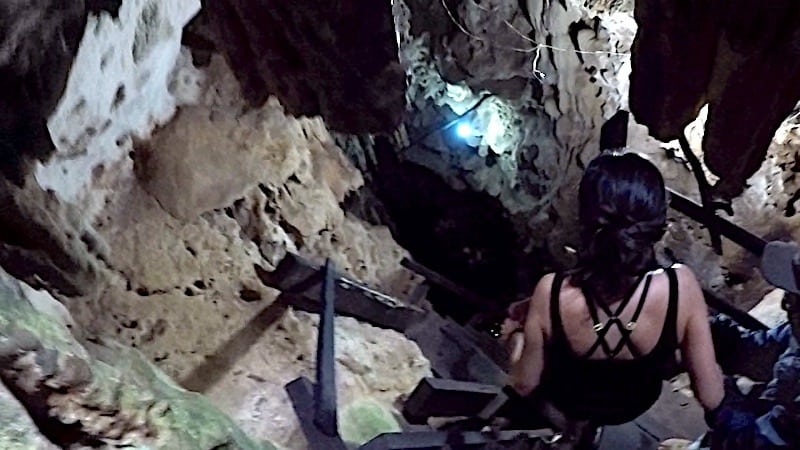
With no time like the present, Kristina jumped right in. My heart was racing – I’m still not completely used to swimming in black water – but I soon followed.
The other two tourists made their way up the ladder. Kristina and I grabbed hold of the rope strung across the middle and hung out in near silence. The splashing of water from our own movement is basically all that we heard. And the sight was only filled with the dim light on the steep walls surrounding us.
(Sorry about the noise in all of these photos! It was VERY dark and we couldn’t bring down much gear. Got a little video out of it that’ll be on YouTube someday soon.)
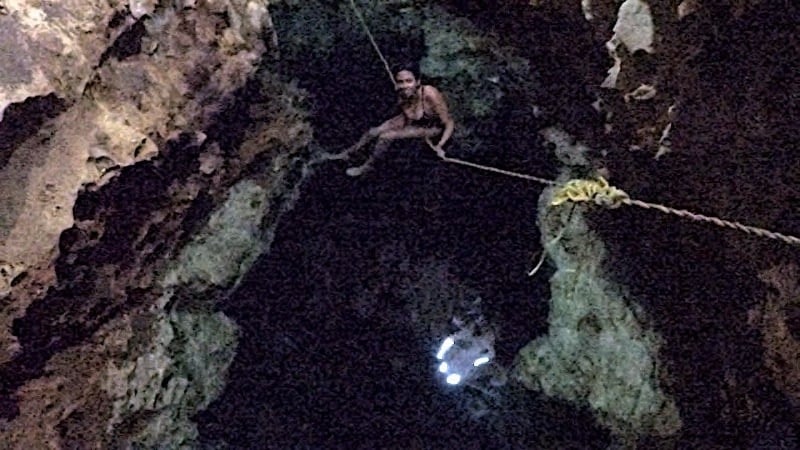
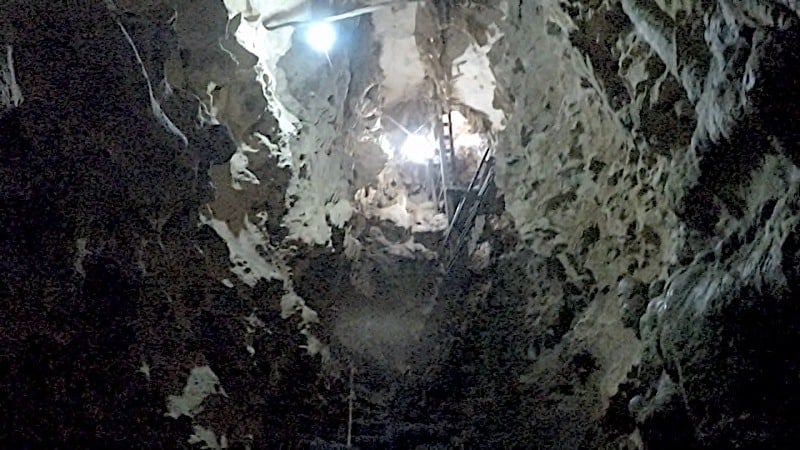
I would have loved to have a solid underwater headlamp like this one from Underwater Kinetics. We love our headlamps for camping, but they aren’t fully waterproof.
But the darkness made the experience incredible as well. What a start to these cenotes!
A Family Affair at the Second Cenote Cuzama: Santa Cruz
After we hung out in the black water for a bit and climbed out of there, we walked over to the second cenote in the area, Santa Cruz. This one has a much larger opening at the ground level, with two trees growing out from the ground below. One has a trunk at least 2 ft (60 cm) in diameter.
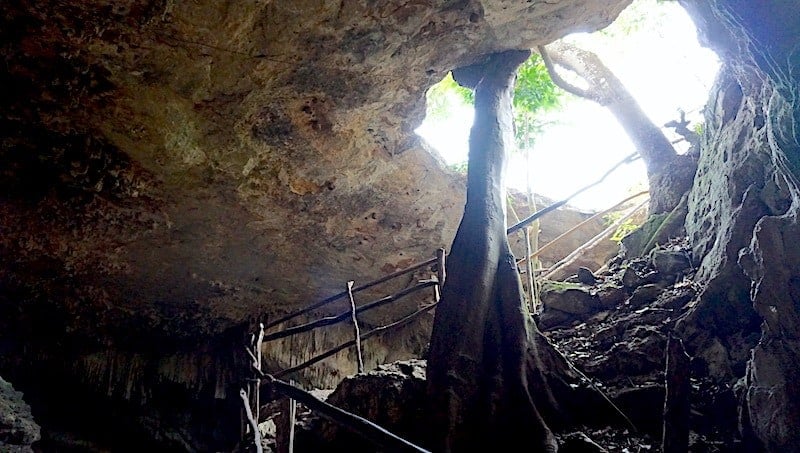
The short staircase landed on a pathway that led three different directions. To the right and straight were small trails where you could explore the cave. But it’s only about 250 ft (75 m) wide, so don’t expect a major hike.
Down to the left is a landing area with steps carved out of the soft limestone rocks. This area receives natural sunlight since the opening is so large.
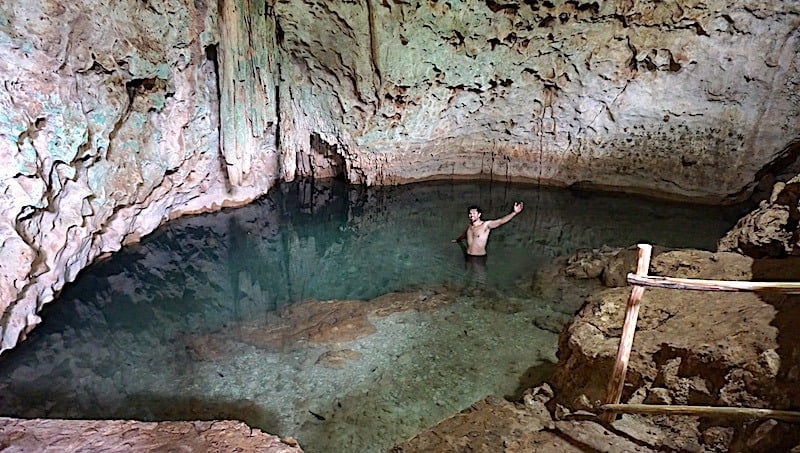
At the base of the steps is a small pool. It starts off only a foot or so deep, then makes way to a depth of about three feet (1 m). Somewhat sizable fish live in this one, actually catfish. Whiskers and all. They left us alone and weren’t a big deal.
We hung out there for a few minutes, then went up toward the light and back into the cart to make our way to the third and final cenote.
The Grand Finale – One of the Best Cenotes Near Merida: Chelentun
Our guide told us the last one, Chelentun, was the best. And to no one’s surprise, he was right. After we cruised along the old mining tracks for about 20 minutes, passing through a beautiful area only developed with this track and a few stone walls, we reached the entrance.
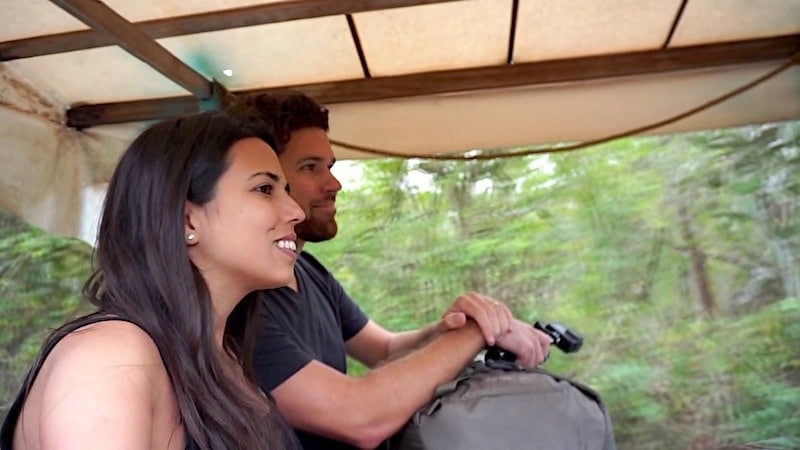
At this one, the ground opening is large and opens up into a massive cave far below. If the staircase wasn’t there and you happen to stumble in, it’d probably be the last thing you do.
Thankfully for us, a very nice staircase heads directly down. Hand railings on both sides and solid footing underneath make this suitable for anyone capable of climbing stairs.
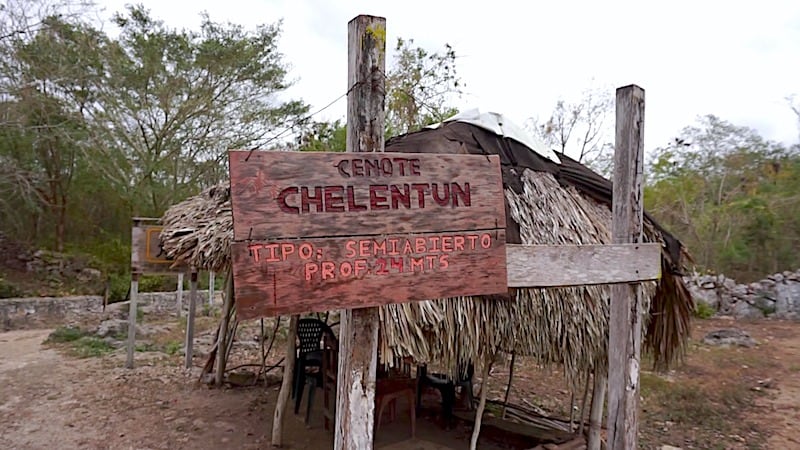
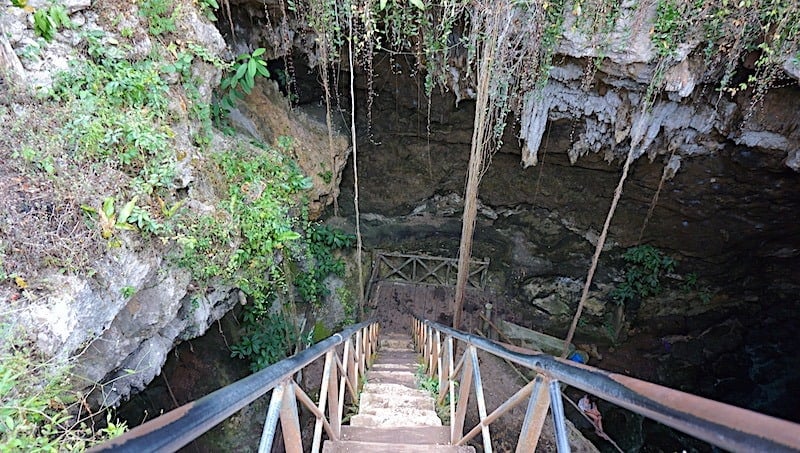
On the way down, we discovered this place was something special. Not only is this cave deep, but it’s also wide. The stairs land on a nice area of solid ground for you to put your things on. Two entrances lead down into the water.
The area closest to the staircases is full of vibrant blue water, light up by the sun. But the water keeps going all the way to the back of the cave, about 150 ft (45 m). So far back, that by the end of it, the water is pitch black – once again. And the sign says the water is almost 80 ft (24 m) deep!
We hopped in and hung out in the shallow area for a minute. Then soon discovered that the small fish here are actually somewhat aggressive. It’s a little gross – and a very weird feeling – but they feed on dead skin. So they gentle nibble on your feet. And as we stood there longer, they even started on our legs and went for my back.
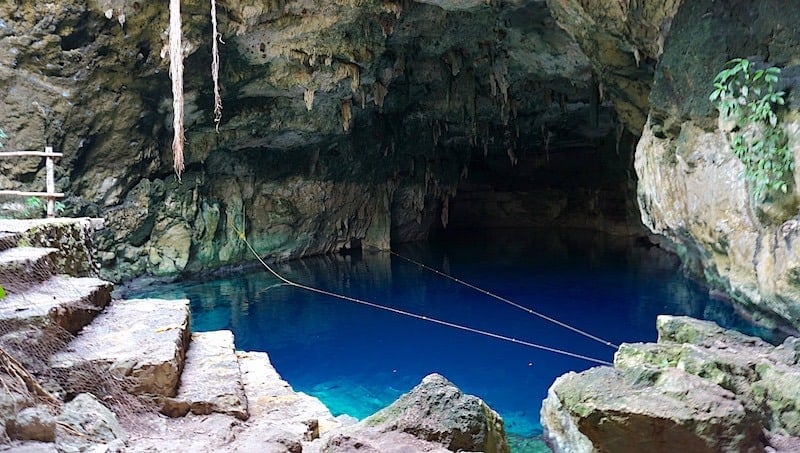
Swimming into the Black Water, Once Again
So we swam off. The movement keeps them away. Then we hung out on one of the two ropes hanging in a somewhat deeper section of the pool, just where the pool starts to turn darker.
Kristina asked me if I’m going to swim into the back part of the cave. No way! I immediately respond. Ok, hand me the camera, she says with a smirk on her face. And starts off into the blackness.
Well, I can’t just let her die alone. What would I tell her mother? So I go with. Heart racing once again and into the blackness we go. After a bit of swimming deeper and deeper into the cave, we slowly approached the far end of it. Turning around, we saw an incredible view of the staircase glowing from the sunlight and the incredible blue water below. An amazing sight that made the creepy swim well worthwhile.
We hung out in the Chelentun pool and on the shore there for about an hour – they give you plenty of time. We hopped back on the cart and rode to the parking lot. Said thank you to our guide (gave him a nice tip) and drove back to Merida, smiling and recounting the experience the whole way.
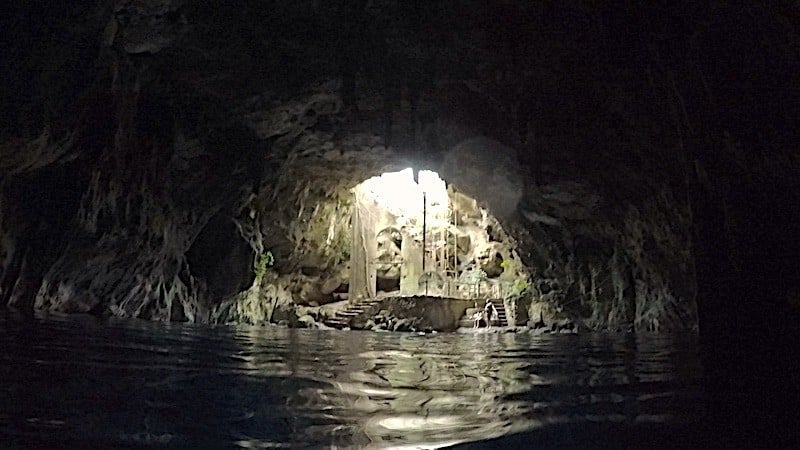
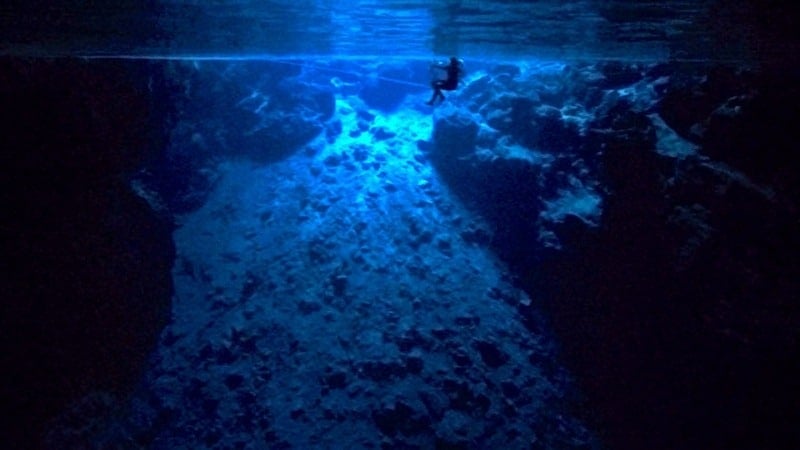
Getting to Cenotes Cuzama from Merida
By car: The easiest way to get to cenotes Cuzama (specifically Paradero Cenotes Chunkanán) is to drive from Merida. It takes just over an hour and there is parking right at the entrance. You will drive through the town of Cuzama – and pass plenty of other cenote sites, including the large government-sponsored one – before you arrive at the small parking area.
By colectivo: These leave from the Noreste terminal at Calle 67 & Calle 50 and head to Cuzama for about $20 pesos. You will then have to take a three-wheeled moto taxi to the entrance for about another $20 per person. Don’t be afraid to haggle a bit for the mototaxi option because they regularly charge tourists inflated prices. And make sure to insist that they take you to Chunkanán. I’ve been told it might be best to just tell them go to Chunkanán, rather than the cenotes, because they will just take you to whichever cenote they get a commission from.
By tour:
By bus: The same Noreste terminal has buses to Cuzama for $18 pesos. Then you’ll take the mototaxi listed above.
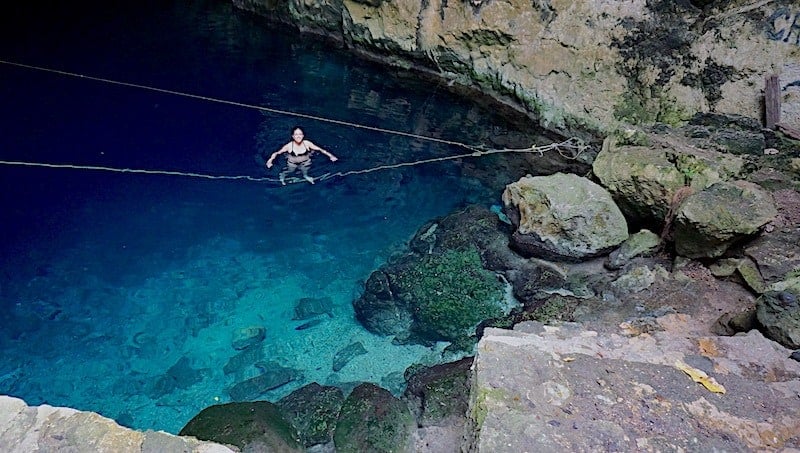
Cost and What to Bring
The current charge is $400 pesos ($20 USD) per cart, up to 4 people. This gets you a small little mining cart made of wood and metal, plus a friendly guide and a horse to pull the cart to all three cenotes.
Don’t forget your swim shorts, a towel, sandals, and perhaps some food or drinks. If you need sunscreen, make sure to use mineral based ones like this one because the cenote ecosystems are fragile.

Other Cenotes Cuzama and Cenotes Near Merida
As mentioned above, there are tons of other cenotes in the area. We’re sure a lot of these are excellent, so here is a comprehensive list of what is in the immediate area, as well as some of the best cenotes near Merida:
Parador X’Tohil – You will drive past these before entering the town of Cuzama. People go here mistakenly thinking they are the best Cenotes Cuzama. They seem to be significantly smaller than Cenotes Chunkanan.
Santa Barbara – These are located just east of Cuzama in the town of Homun. Another set of three which gets a lot of the traffic coming from Valladolid.
Costco Cenote – No kidding, there is a cenote in the parking lot of the Costco in Merida. Definitely not the most memorable experience, but if you want to check it out, go for it!
Cenote Sambula – Small cenote an hour northeast of Merida in Motul. Cheap entrance fee ($12 pesos).
Dzibilchaltun – Near a ruin site with the same name just north of Merida. One cenote, strict, and many say overpriced due to tour groups.
Yaal Utzil – In the Mucuyche area an hour southwest of Merida. Just one cenote, but has platforms to jump off of into the water.
San Ignacio – Located in Chochola, fairly close to Yall Utzil. This small cenote can be part of a day visiting other cenotes in the area.
Summary of Cenotes Cuzama: Paradero Cenotes Chunkana
The three cenotes Cuzama are more specifically named Paradero Cenotes Chunkana, and include three amazing centoes: Tzapakal, Santa Cruz, and Chelentun. There’s a reason they’ve been here so long and are known as the best in the area.
All three at the Cenote Chunkana site offer vastly different experiences. Tzapakal is a small fissure that’s adventurours and fun. The shallow pool at Santa Cruz is great for exploring the wide cave. And the massive Chelentun is full of incredible water and views with the sunlight beaming down. We’d go back in a heartbeat.
Would you swim in the black water of the first cenote here? Or does hitting the beach sound better? Leave us a comment to share your opinion!
Like This Post? Pin It!
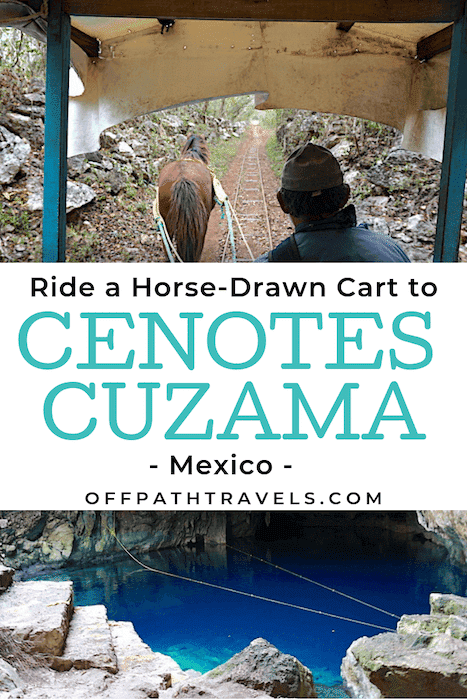


What a great post! It sounds like such a fun adventure. Can you please tell me if life jacket rental is available at the cenotes you visited? My kids can swim but the exceptionally deep water would give me pause.
It’s usually very common for life jackets to be available for rent at most cenotes in the region. I believe that’s the case at Cuzama as well. Just make sure to ask before getting on the cart. Some of the pools are quite deep and its understandable to use caution.
Good Day Kristina & Michael…
We are a family of three from Canada, transitioning to global slow-travel and world-schooling our teen starting this coming November, with 6 months visit abroad and 6 months return to home base. Merida is our very first stop in our nomadic adventure and came across your post while doing our preliminary research on “cenotes”. We are looking to make this exploration a whole day family event. And in conjunction with our world-schooling efforts, we are also taking this opportunity to “learn and explore” everything about cenotes.
Wondering if you are able to provide insights so we can “connect-the-dots” so to speak on 1) direct public transportation from/to Merida, 2) booking/reservation instructions in advance and 3) recommendations on food establishments nearby Paradero Cenotes Chunkanán. As for direct public transport, the family was wondering if we are able to take “collective or bus” from Noreste terminal and be dropped-off and/or picked-up closer to the location (ie walking) vs mototaxis from city centre Cuzama (ie is it a “safe” walkable distance?!?) Additionally, was also wondering about change of clothes and/or the safe-keeping of personal belongings while exploring the three cenotes.
Looking forward to your input and feedback. Thanks in advance
Hi there! Sounds like you have an exciting adventure ahead. Merida is a great place to start off and the cenotes will be a wonderful learning opportunity.
First, keeping care of your personal belongings while at the cenotes is usually no big deal. It’s similar to visiting a beach or pool where most people have bags that they carry with them and place near the shoreline. We never had any issues with people messing with our belongings, including a good amount of camera gear and electronics, but of course, it is wise to be aware of your things and keep an eye on them when possible. You can get small dry bags if you have major concerns and would prefer to keep some valuables with you at all times, but it’s really not necessary 99.9% of the time.
The easiest way to answer all of your questions without overwhelming you is to check out the available guided all-day tours from Merida. There are excellent options from TripAdvisor’s Viator and GetYourGuide which take care of round-trip transportation from your hotel/rental in Merida and have lunch planned out.
If you don’t like the sound of that, it might be worthwhile to rent a car for a short period to visit the cenotes, ruins, and other attractions outside of Merida. It’s an excellent way to get around more efficiently and see exactly what you want over the span of a few days. Sometimes you can rent them for incredibly cheap rates and actually save money compared to the various public transit options. Here is our recommended car rental agency. I know that some people have reservations about driving in Mexico, but as long as you are a careful driver and avoid driving at night, there really isn’t much to worry about. Google Maps navigation works perfectly well too.
Since we drove out, I am not certain exactly where the buses or colectivos will drop you off. Typically they make it quite easy to get to the main attractions, but sometimes it can come at an extra fee. You can check the bus information and purchase tickets on Busbud.com. If the drop-off site isn’t very close to the attraction, it’s usually best to take them up on the offer for the last mile that they provide, such as the mototaxis. Walking on the roads in rural Mexico can be a bit risky due to a lack of shoulders/sidewalks. The only problem is that sometimes the fees for short distances can be quite steep and difficult to plan ahead for. Sometimes they’re perfectly reasonable right off the bat, other times you might want to try haggling a bit. Something I’m sure you’ll get used to over your 6 month trip, if you aren’t already experienced with it.
For specific restaurants, the town is quite small with just a few offerings. It might be worth it to ask a local or a guide at the cenotes which they think is best, or simply check them out on your own to see what looks best for your needs, but Restaurante cozom-Ha has overall positive reviews. The combined Cenotes & Restaurant Santa Bárbara also has a lot of positive reviews for the cenotes and the restaurant food.
Hope this helps! Enjoy your travels. I’m sure you’re going to create some incredible memories.
Thank you so very much for your informative write up! We decided to head to the Chunkanan with three kids ages 4 to 9 today and had such a a wonderful day. Your descriptions were right on! We took a taxi from Merida, the taxi ride included a 3-hour wait while we explored the cenotes. We all loved the rickety horse-drawn cart. The kids were able to enjoy the Santa Cruz and Chelentun cenotes, but passed on the steep decent into Tzapakal for reasons you described. My husband and I took turns climbing in to take a peek though. Really fun day! Thank you!
Isn’t the cart such a fun experience?! We’re very happy to hear you had an enjoyable time. I can still feel the excitement from descending into Tzapakal; understandable that the little ones aren’t quite ready for that yet. Thank you for leaving such a supportive comment and we’ll be around to help out with more adventures!
Hi there,
Thanks so much for making this post! I’m excited to check out these cenotes in the upcoming weeks. How long would you say the tour took you? I am trying to plan out our time in Merida.
Thanks and happy travels 🙂
I hope you get a chance to visit! The time you spend there depends heavily on how long you want to stay in each cenote. I’d say 1.5 – 2 hours minimum, but if you like to swim like us, then more like 3 hours. The cart rides themselves took around 45 minutes (but this also depends on the driver and horse). Have fun! We can’t wait to go back, and we often tell fellow travelers stories from this location. One of our favorites to this day!